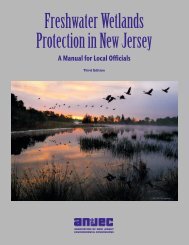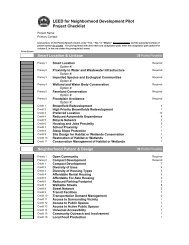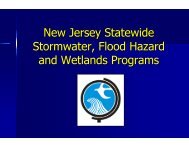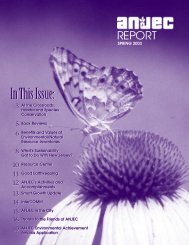In This Issue
Municipal Regulatory Powers in Category One Stream ... - ANJEC
Municipal Regulatory Powers in Category One Stream ... - ANJEC
Create successful ePaper yourself
Turn your PDF publications into a flip-book with our unique Google optimized e-Paper software.
Municipal Regulatory<br />
Powers in Category<br />
One Stream Buffers<br />
By John Thonet, Environmental<br />
Planning and Design, Thonet<br />
Associates <strong>In</strong>c.<br />
The New Jersey Department of<br />
Environmental Protection’s (NJDEP’s)<br />
stormwater regulations require municipalities<br />
to pass stormwater ordinances<br />
that include, at a minimum, the State’s<br />
stormwater standards. One required<br />
standard prohibits encroachment<br />
within 300-foot Special Water Resource<br />
Protection Areas (SWRPAs), or buffers,<br />
on either side of Category One streams<br />
unless the applicant demonstrates that<br />
the functional value and overall<br />
condition of the SWRPA would be<br />
maintained to the maximum extent<br />
practicable.<br />
According to Larry Baier, Director of<br />
NJDEP’s Division of Watershed<br />
Management, “...a municipality may<br />
disapprove any proposed encroachment<br />
that it concludes does not satisfy<br />
these regulatory requirements. A denial<br />
of a special water resource protection<br />
area encroachment by the municipal<br />
authority is not subject to review and<br />
approval by the (NJDEP).”<br />
However, if the local board agrees to<br />
permit encroachment into a SWRPA,<br />
that approval is subject to further<br />
review by the NJDEP. <strong>In</strong> this regard, the<br />
NJDEP Commissioner’s January 3, 2007<br />
Administrative Order directs that:<br />
“Effective immediately, the Department<br />
shall not approve any encroachment<br />
into a special water resource<br />
protection area...unless the applicant<br />
demonstrates that the functional value<br />
and overall condition of the special<br />
water resource protection area will be<br />
maintained to the maximum extent<br />
practicable....”<br />
Thus, the regulations prohibit both<br />
the NJDEP and municipal boards from<br />
permitting encroachments into the 300<br />
foot SWRPAs unless the applicant<br />
demonstrates that the SWRPA’s<br />
functional value and overall condition<br />
will be maintained to the maximum<br />
extent practicable. Functional Value<br />
Assessment guidance is available at:<br />
www.nj.gov/dep/watershedmgt/DOCS/<br />
FunctionalValueAnalysis1-2-07.pdf<br />
State Plan Cross<br />
Acceptance<br />
Update<br />
By Barbara Palmer,<br />
ANJEC Land Use Planning<br />
Project Director<br />
“Of the 84 events that<br />
need to happen to complete<br />
Cross Acceptance, 72 have<br />
successfully taken place,”<br />
Acting Executive Director<br />
Ben Spinelli of the Office of<br />
Smart Growth (OSG)<br />
reported at the April 18 State<br />
Planning Commission<br />
meeting, thanking his staff<br />
and the State Planning<br />
Commission members for<br />
their efforts.<br />
Cross Acceptance, the<br />
process of comparing<br />
municipal and county plans<br />
with the State Plan and the<br />
dialogue among the participants<br />
to achieve consistency<br />
among the plans, is indeed a<br />
large undertaking. Every<br />
municipality was asked to<br />
report to their counties in<br />
2004, the counties prepared extensive<br />
reports for the state. Now the Office<br />
of Smart Growth is holding four<br />
meetings on each of these 21 county<br />
reports. For each county there is an<br />
internal OSG meeting, a meeting with<br />
all the State Agencies involved, a<br />
meeting with the county staff, and then<br />
a local public hearing.<br />
The public’s best opportunity to<br />
comment on their county’s Cross<br />
Acceptance negotiation with the State<br />
is at the public hearing. A schedule of<br />
the hearings is posted on the OSG web<br />
site: www.nj.gov/dca/osg/plan/<br />
crossacceptance.shtml: Essex, Warren,<br />
Berge and Somerset scheduled in May;<br />
Middlesex, Camden, Monmouth,<br />
Morris, Mercer, Hunterdon, and Ocean<br />
to come.<br />
To prepare for a hearing, the<br />
Office of Smart Growth posts<br />
meeting materials on their<br />
website (above) that include<br />
the negotiation worksheets<br />
of policy issues to be<br />
resolved between the state<br />
and the county, as well as<br />
maps and other reports.<br />
Municipalities should<br />
review their final county<br />
Cross-Acceptance report<br />
to make sure it accurately<br />
reflects the land use<br />
plans of the municipality<br />
and that it protects natural<br />
resources. Any issues can<br />
be raised at the<br />
hearing, with each<br />
speaker permitted 3<br />
minutes to address the<br />
state and county staff.<br />
The public hearings<br />
are the last step<br />
before the release of<br />
a draft new State<br />
Plan. The draft State<br />
B. PRETZ<br />
Plan will reflect the<br />
resolution of the<br />
issues, but can be<br />
commented on once<br />
more at 6 hearings to be held around<br />
the state, or in writing, before a final<br />
State Development and Redevelopment<br />
Plan is released.<br />
ANJEC encourages all interested<br />
parties to attend the public hearings.<br />
PRINTED ON RECYCLED PAPER<br />
ANJEC REPORT - Spring 2007 15












